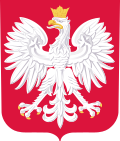| Coat of arms of Warsaw | |
|---|---|
 | |
| Versions | |
 Design for Grand Coat of Arms of Warsaw ("Semper invicta") | |
 Coat of arms of Warsaw during the communist era (1944–1989) | |
| Armiger | Capital City of Warsaw |
| Adopted | 1990 |
| Crest | Mermaid of Warsaw |
| Motto | Contemnit procellas |
| Earlier version | 1390-1989 |
The coat of arms of Warsaw (The Warsaw Mermaid) consists of a syrenka in a red field. This imagery has been in use since at least the mid-14th century. [1] The syrenka has traditionally held a silver sword although this does not appear on more recent versions.





